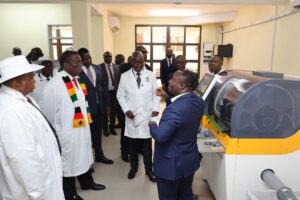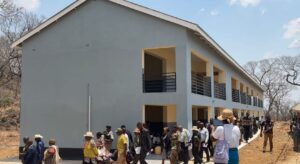2nd Republic Lives up to Expectations…
5 min read
…as Vic Falls–Bulawayo Road Upgrade Gathers Momentum
Hwange – Work on the Victoria Falls–Bulawayo highway, one of Zimbabwe’s most strategic road arteries, is advancing at an impressive pace, with major visible progress already recorded on the Hwange section.
The project, long awaited by transporters, tourists, and local communities, is now transforming a critical transport corridor that connects the country’s industrial hub in Bulawayo to the world-renowned Victoria Falls, a UNESCO World Heritage Site.
His Excellency the President Dr. ED. Mnangawa has spoken to the Vision that seeks to make all roads and related road infrastructure world class, making them flawless to traffic. This is enunciated in the National Development Strategy 1 Blueprint.
Indeed, the mantra that Nyika Inovakwa neVene Vayo is seeing the light of day as this and many other such projects are seeing the light of day.
Once complete, the rehabilitated highway promises to redefine travel, trade, and tourism across Matabeleland North and beyond, offering a safer, more efficient, and more scenic route for all road users.
Stretching across some of Zimbabwe’s most economically significant regions, the Victoria Falls–Bulawayo Road is not just a road—it is a lifeline for commerce, tourism, and community development.
The route serves as a crucial hauling corridor for mining exports, agricultural produce, and other goods destined for regional and international markets.
With the revival of Hwange’s coal mining activities, the emergence of new industrial zones, and the growing flow of tourists to Victoria Falls, pressure on the old road had intensified.
Cracks, potholes, and uneven surfaces had become common hazards, leading to rising accident rates and vehicle maintenance costs.
The ongoing rehabilitation, therefore, represents a major infrastructural renewal—one that aligns with Zimbabwe’s broader National Development Strategy 1 (NDS1) objectives of improving transport infrastructure and facilitating economic growth.
“This road is the backbone of trade and tourism in the western region. Its modernization is not just about asphalt and tar—it’s about connecting people, products, and possibilities,” said an official from the Ministry of Transport and Infrastructural Development.
Currently, the Hwange section has become a symbol of progress, with visible upgrades already transforming the driving experience.
Road crews have been working tirelessly to ensure that resurfacing, drainage systems, and signage meet modern standards.
Motorists traveling through this section are already noting the difference.
Smoother driving surfaces, widened shoulders, and improved visibility have enhanced road safety, particularly for long-distance truckers and tourist buses navigating the route daily.
Local residents in Hwange have also welcomed the project, noting its potential to stimulate economic activity.
“When roads improve, everything else improves,” said one Hwange business owner. “Suppliers arrive on time, tourists stop over more often, and even small roadside businesses benefit.”
Few destinations capture the world’s imagination like Victoria Falls, often referred to as “The Smoke That Thunders.”
As a flagship tourist attraction for Zimbabwe and the wider Southern African region, accessibility is key to its continued growth.
The upgraded highway will ensure that visitors—both local and international—can travel comfortably and safely from Bulawayo to Victoria Falls, enjoying a seamless journey through landscapes rich in wildlife, culture, and natural beauty.
Tourism operators have long emphasized that improved road infrastructure is a catalyst for destination growth.
“For many of our visitors, the journey is part of the adventure,” said a tour operator based in Victoria Falls.
“When the road is good, travelers are more likely to stop, explore, and spend along the way. It’s a win for the entire tourism value chain.”
From the Matobo Hills near Bulawayo to the Hwange National Park en route, the improved road also enhances access to multiple attractions, potentially extending tourist stays and increasing revenue across the region.
Beyond tourism, the upgrade brings critical safety benefits. The old highway, though scenic, had become notorious for its narrow lanes and deteriorating surfaces that posed risks, particularly to heavy haulage trucks ferrying coal and goods.
With the new improvements, road users can expect clear markings, stronger pavements, modern signage, and better lighting at key junctions.
The inclusion of proper drainage systems also means the road will be more resilient to heavy rains—a vital consideration given climate change’s growing impact on infrastructure durability.
The enhanced efficiency will translate into reduced travel times and lower vehicle maintenance costs, strengthening logistics and boosting investor confidence in Zimbabwe’s road network.
Crucially, the project is not only about asphalt—it is also about empowerment and local participation.
Through subcontracting and employment opportunities, many local residents have gained income and skills from the construction process.
For communities along the corridor—such as Lupane, Hwange, and Dete—the road upgrade opens doors to new business prospects.
Service stations, hospitality facilities, and roadside markets are expected to thrive as traffic flow increases and travel conditions improve.
“This project is already changing lives,” remarked a local councillor. “When you bring a major road to good condition, you are bringing development, hope, and opportunity.”
The success of the Victoria Falls–Bulawayo road upgrade is expected to serve as a model for future infrastructure projects across Zimbabwe.
It reflects the government’s commitment to revitalizing key national routes and integrating modern engineering standards with local needs.
The emphasis on sustainability, quality workmanship, and phased implementation ensures that progress is both steady and measurable.
With continued investment and monitoring, the road’s transformation will stand as a testament to what can be achieved through coordinated planning and vision.
As work continues, optimism is building across the Matabeleland region. Stakeholders—from truck drivers to tour operators, from local leaders to business owners—are united in their belief that this project will unlock a new era of connectivity and prosperity.
Once fully completed, the Victoria Falls–Bulawayo highway will not only strengthen Zimbabwe’s transport infrastructure but also signal the nation’s readiness to embrace growth through modernization.
Every kilometer laid is a step toward a safer, more prosperous, and more accessible Zimbabwe—a country where the journey to the majestic Victoria Falls becomes as memorable as the destination itself.
——————————————




